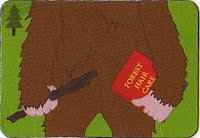A few weeks ago, I listed a number of predictions about the X-Factor 2011, and here they are (so far) listed in bold with my comments.
* At least one finalist to have estranged parent or sibling - I appreciate I'm late with this, given that immediately after the first episode, one of the judges discovered a brother she never knew she had.
This hasn't been uncovered yet, but give it time. Let's not forget that a few weeks ago, Tulisa's long lost brother told us all about her childhood and upbringing.
* Gary Barlow to have one of his Take That mates at the judges' house stage (and it won't be Robbie)
So that's score +1 for the Take That predicition, but -1 for suggesting it wouldn't be Robbie. You win some, you lose some (a philosophy that might be of use to all those 'this is life or death for me' contestants).
* One of finalists to have been bullied at school
We'll see...
* There will be the formation of a boy group and girl group, made up of the boy dregs and girl dregs at the end of the boot camp stage. "We want to put you together into a group [because we haven't got enough groups already]."
Yes. It was an easy one, but it was worth mentioning.
* These synthetic dregs-groups to go through to the live shows (you didn't think the judges would put them together and not let them go through, did you?).
And again, I was correct. Too easy, really, but hey, some points are worth getting.
* These synthetic groups to get eliminated in first two weeks - first the girls (who will dress inappropriately) and then the boys (who can't sing as a team)
I should qualify that I was expecting the public vote to start in week one, so give me another week here, folks!
* Simon Cowell to make a guest appearance, to much fanfare and flashing lights
Still pending.
* Last year's winner (whoever that was) to release album just in time for Christmas
Oh goodness me, was that really Matt Cardle hawking his new single last Sunday? Really? Imagine that.
* Louis Walsh to pick a wildcard act (or just a wild act) which is no good, but which secures the votes of those who deliberately vote for the worst (Jedward, Wagner).
And this year, he's called Johnny. It would have been Goldie too but she had the sense to leave.
* There will be extensive media coverage of an apparent spat between two of the judges, probably the two ladies, but possibly the two blokes
Still waiting for this one, although the drama over "head judge" on The Xtra Factor was a parody in and of itself. Nice one, ITV2.
* One of the acts to suffer with a cough/cold/laryngitis/glandular fever part way through the TV shows
Still pending... just give them a few weeks.
* Two of the acts to form a 'secret' relationship, again with much media coverage
I haven't worked out who this will be yet, but give me a week or so and I'll be able to suggest names.
Now for my additional predictions, having seen week one.
I wish I'd mentioned the excessive use of Orff's Carmina Burana classical piece every time something interesting (or dull) happens... like the judges walk on stage... or walk off the stage... otherwise, I'd predict that they'd use it.
The synthetic girl group (which I've mentioned before) to wear excessively revealing clothes, and then to draw criticism for it, and then, in the same week, to get voted off.
Michael Jackson week.
Some disastrous cover versions of Take That and Westlife songs.
The judges to criticise each others' acts' "song selections" and "fashion sense" instead of the singing.
Movie Soundtrack Week.
One of the judges, probably Louis, to bend the rules on the allowed songs for "Movie Soundtrack Week" and pick a popular song that featured in an obscure movie.
One of the judges to say, "I think you could really be at risk this week," as a transparent ploy to get people to ring up and vote. Seriously? Do you think that the sales of the CDs and downloads comes close to the total phone revenue for the X-factor? It's all about persuading, cajoling and manipulating people into voting. I might start a whole other post on the manipulation of the public (and the public vote) by the judges' comments - "People really need to pick up the phone and vote for you this week" being a less subtle one, and "I think you're at risk" being slightly less obvious.
Deadlock. Every week that it's possible, the judges will deploy deadlock instead of actually kicking off the weaker act. Remember Jedward, hmm, and their excessively long stay on the show at the expense of acts who could sing better but didn't generate the same interest or phone votes?
I also wish I'd remembered that in the first few weeks, one of the judges usually makes a disastrous song choice and immediately dooms their act. In 2007, it was Daniel DeBourg it was "Build Me Up Buttercup", this year it was Jonjo with "You Really Got Me." Talk about a rabbit in the headlights (and in order to discuss rabbit in the headlights, I'd like to talk more about the ever-pale-faced Leon Jackson).
I predict that they'll release "The Charity Single" ... the money spinner now available with with 'extra' goodwill.
That's all for this time, so, keep watching (but not voting) until next time, when we'll probably discuss the allegations of phone-lines being rigged, of judges deliberately throwing their acts to the lions, and of not eliminating the right acts.












